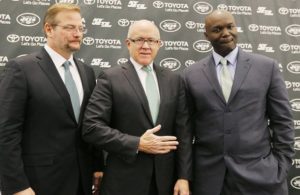Ryan Pace and John Fox have been together in Chicago for two years, as have Mike Maccagnan and Todd Bowles in New York, while Sashi Brown and Hue Jackson in Cleveland and Chris Grier and Adam Gase in Miami just finished their first seasons. Finally, GM John Lynch and HC Kyle Shanahan just arrived in San Francisco, while Buffalo added HC Sean McDermott in January before switching GMs and bringing in Brandon Beane after the 2017 Draft.
Washington currently has a vacancy at General Manager, after firing Scot McCloughan in March after two winning years. Four other teams (in addition to Washington and Buffalo) are in the unique situation of having a head coach with a longer tenure than its GM:
- In 2014, Mike Mularkey was hired to be Tennessee’s tight ends coach. Midway through the 2015 season, the Titans fired Ken Whisenhunt and promoted Mularkey to interim head coach. Two months later, Tennessee fired GM Ruston Webster and hired Jon Robinson from Tampa Bay; Robinson, despite significant backlash, chose to retain Mularkey as the team’s head coach. That has worked out pretty well so far: after going 3-13 (2-7 under Mularkey) in 2015, the Titans went 9-7 in the first year under Mularkey and Robinson.
- Ron Rivera has been in Carolina since 2011. After a 6-10 first season, Carolina began the year 3-9 in 2012, prompting me to write how attractive this potentially vacant job would be. Well, the Panthers finished 7-9 and retained Rivera, but fired Marty Hurney, who had been the team’s general manager since 2002. The Panthers then hired Dave Gettleman, who retained Rivera, and the rest has been history. Rivera has been named the AP Head Coach of the Year twice since Gettleman arrived.
- The Lions hired Jim Caldwell in 2014, just a year removed from his impressive playoff run that resulted in a Super Bowl as the Ravens offensive coordinator. At the time, Detroit’s GM was Martin Mayhew, but he was fired midway through 2015 with Detroit just 1-7. The Lions hired ex-Patriot Bob Quinn in 2016, who chose to retain Caldwell, after the Lions went 6-2 down the stretch in 2015. Like Mularkey and Robinson, Caldwell and Quinn went
- Finally, the Colts brought in Chuck Pagano and Ryan Grigson in 2012. Indianapolis followed three straight 11-5 seasons with a pair of 8-8 campaigns; after nearly firing one or both men after 2015, Colts owner Jim Irsay finally ended the failed marriage by canning Grigson after the 2016 season. He’s been replaced by Chris Ballard, who is retaining Pagano… so far.
The table below shows this information for all 32 teams. It’s pretty self-explanatory, but for clarity’s sake, note that the years column excludes the yet-to-be-played (spoiler!) 2017 season. [continue reading…]


